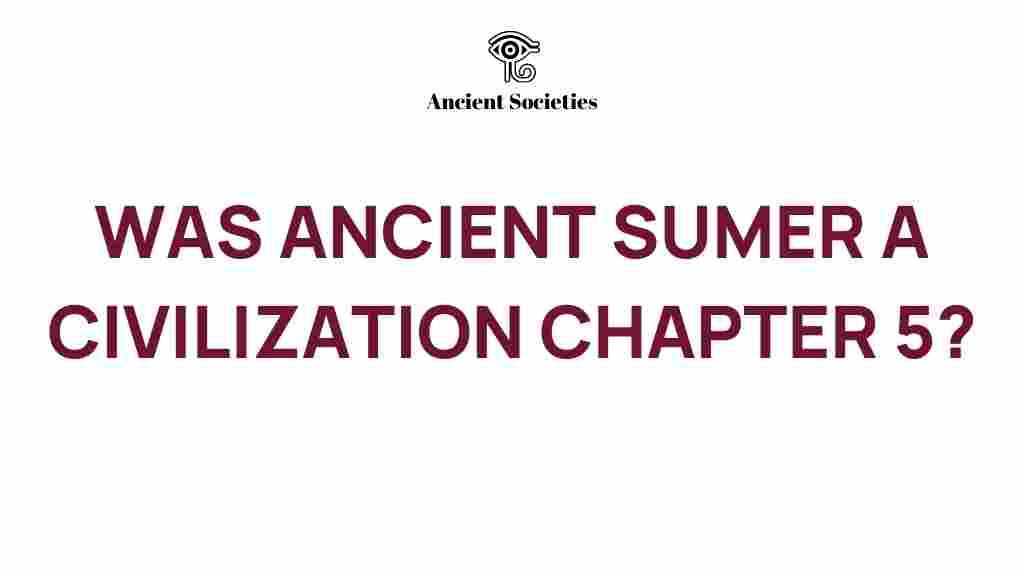Unveiling the Mysteries of Ancient Sumer: Was It a True Civilization?
The history of Ancient Sumer is a captivating journey into the depths of human civilization. Often regarded as one of the earliest civilizations in human history, Ancient Sumer emerged in the region of Mesopotamia around 4500 BCE. This article explores the various dimensions of Sumerian society, including its cultural achievements, societal structure, early writing, and urban development, to determine whether it indeed qualifies as a true civilization.
Understanding Civilization
Before diving into the specifics of Ancient Sumer, it’s essential to define what constitutes a civilization. Scholars generally agree that a civilization must exhibit the following characteristics:
- Urban Development: The presence of cities and complex urban centers.
- Social Structure: A defined hierarchy and social classes.
- Political Organization: A governing body or system of leadership.
- Cultural Achievements: Advances in arts, science, and technology.
- Writing System: The ability to record information and communicate through written language.
With these criteria in mind, let us explore how Ancient Sumer fits this definition.
Urban Development in Ancient Sumer
Ancient Sumer is famously known for its urban centers, which were among the first in the world. The Sumerians established city-states such as Ur, Uruk, and Eridu. These cities featured:
- Walled Enclosures: Protecting the city from invaders.
- Complex Architecture: Ziggurats, temples, and residential areas.
- Infrastructure: Development of roads and irrigation systems to support agriculture.
The urbanization of Sumer facilitated trade, cultural exchange, and the establishment of a structured society, further solidifying its status as a true civilization.
Societal Structure of Sumer
The societal structure in Ancient Sumer was complex and hierarchical. It consisted of several classes:
- Nobility: Priests and rulers who held significant power.
- Free Citizens: Farmers, artisans, and merchants who contributed to the economy.
- Slaves: Often war captives or those in debt, they formed the lowest tier of society.
This structured social hierarchy allowed for a division of labor, which led to specialization and greater efficiency in various sectors, including agriculture and trade.
Cultural Achievements and Contributions
The Sumerians made remarkable contributions to human culture. Some of their notable achievements include:
- Early Writing: The invention of cuneiform, one of the first writing systems, which was used for record-keeping and literature.
- Mathematics: The development of a base-60 number system, which influences how we measure time and angles today.
- Astronomy: The Sumerians made significant advancements in understanding celestial bodies and their movements.
- Art and Architecture: Stunning sculptures, pottery, and monumental architecture that showcased their artistic prowess.
These cultural achievements highlight the sophistication of Ancient Sumer and its contributions to the development of future civilizations.
Early Writing: The Cuneiform Script
One of the most significant advancements made by the Sumerians was the creation of early writing. Cuneiform, developed around 3200 BCE, was initially used for accounting and administrative purposes. Over time, it evolved to include:
- Literature: Epic poems like the “Epic of Gilgamesh.”
- Legal Codes: Documentation of laws and societal rules.
- Scientific Texts: Records of astronomical observations and mathematical calculations.
Cuneiform laid the groundwork for future writing systems and is considered a monumental achievement in the history of civilization.
Archaeology: Discovering Sumer’s Legacy
The understanding of Ancient Sumer has been greatly enhanced by archaeological discoveries. Excavations in regions like Ur and Uruk have revealed:
- Artifacts: Tools, jewelry, and everyday items that provide insights into Sumerian life.
- Architectural Remains: Ziggurats and temples showcasing their engineering skills.
- Tablets: Cuneiform inscriptions that inform us about their culture, economy, and philosophy.
These archaeological findings have been crucial in piecing together the narrative of Sumerian history and confirming its status as a true civilization.
Troubleshooting Common Misconceptions about Ancient Sumer
As we explore the history of Ancient Sumer, it is essential to address some common misconceptions:
- Myth of Simplicity: Many people believe early civilizations were primitive. However, Sumerians displayed complexity in governance, economy, and culture.
- Assumption of Isolation: Ancient Sumer was not isolated; it engaged in trade and cultural exchanges with neighboring regions, influencing and being influenced by others.
- Underestimation of Technological Advances: The Sumerians were pioneers in technology, developing irrigation systems and metallurgy that were ahead of their time.
Correcting these misconceptions helps us appreciate the sophisticated nature of Ancient Sumer and its role in the broader narrative of human history.
Conclusion: The Legacy of Ancient Sumer
In conclusion, the evidence supports the notion that Ancient Sumer was indeed a true civilization. With its advanced urban development, intricate societal structure, groundbreaking cultural achievements, and the invention of early writing, Sumer laid the foundation for subsequent civilizations in Mesopotamia and beyond.
The legacy of the Sumerians continues to resonate today, influencing various aspects of modern life, from governance to literature and mathematics. As we continue to uncover the mysteries of this remarkable civilization through archaeological efforts, we gain deeper insights into our shared human heritage.
For more information on the fascinating history of civilizations, check out this comprehensive resource that delves into the developments of ancient societies around the world.
By understanding the contributions of Ancient Sumer, we not only appreciate their achievements but also recognize the interconnectedness of human history and the ongoing journey of civilization.
This article is in the category Archaeology and created by AncientSocieties Team
